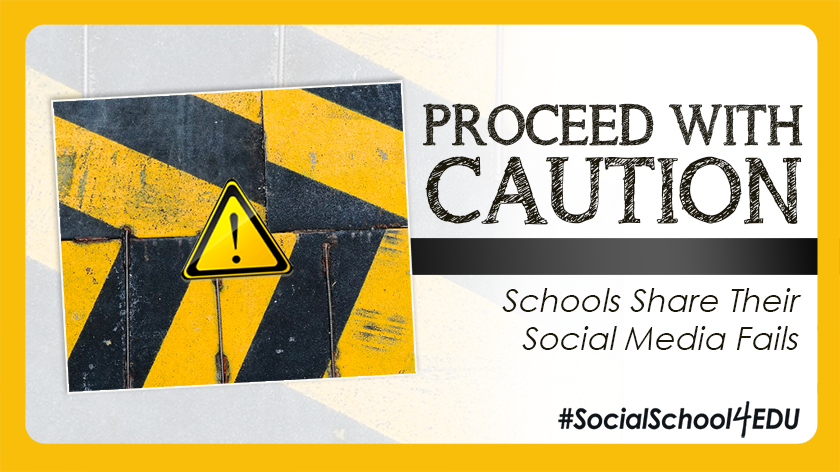Social media is intended to celebrate our students and staff. I’ve been writing about that for 10 years and have even written a book on this topic (order yours today!) But what happens when you post something with good intentions but it ends up making someone upset, sad, or hurt?
Now, I’m not talking about political or even critical comments directed at the school. I really mean when a student or staff member has their personal feelings impacted because of something you posted on social media, no matter your intent.
I reached out to my friends across the country to grab some real-life examples of when this has happened. My hope is that you can learn from these experiences and try avoiding them in your own work! Because of the sensitivity of the stories, I won’t be quoting any of these stories to a person, school, or state, or sharing screenshots of the posts that went awry.
Lesson 1: Boutique Shopping Spree for Students
It all started with a great gesture! A local business owner gave away several shopping sprees for students to use within her boutique. Each student got to purchase a new outfit, and the school social media manager posted the photos on social media.
But quickly, word got back to the administration that other students were making fun of the girls in the photos. The comments on the post were very positive, but the feedback at school among students was completely the opposite. How awful!
Because of the initial positive comments, the school wanted to keep the post up. But finally, after a parent called with concern over the teasing her child was receiving, the post was removed.
What did we learn? Identifying students’ economic status on social media is a concern. Ask for permission if you are ever unsure. Another scenario where this could come into play is Shop with a Cop or back-to-school supply giveaway events. You may want to skip any photos that identify students.
Lesson 2: Sad Student in Background of Photo

Celebrating a classroom project always seems like the right thing to share! Well, this particular picture had a girl in the background who was crying. The mother of the girl called the school, wanting to know what was wrong. The school social media manager felt awful and ended up removing the post.
What did we learn? Closely check the background of all photos! While you probably have a clear focal point, someone will notice what’s in the background. It could be a hand signal, a clothing malfunction, or a student’s facial expression that could cause an issue.
Lesson 3: Uneven Classroom Representation
Pictures of a new auto shop class were captured and shared on social media. There was only one female student in the class. A parent asked where all the girls were – her daughter was in the auto class, but at a different period of the day – and complained that not all the classes were pictured. She especially wanted to see more female students, including her daughter. The post was not removed in this case.
What did we learn? You will never please everyone! You can respond to comments with an honest answer. In this instance, I might have said, “Thanks for sharing your concern. We do our best to celebrate all of our students but often are unable to get every student in every class. We’ll try to feature a different class the next time our auto shop has something fun to share!”
Lesson 4: Potentially Offensive Hand Signals
We see this one ALL the time! A school posted a celebratory picture of its junior high football team after a game, and two athletes were making “gang” signs. Some people pointed it out in the comments, asking what the students were doing. Ultimately, the school pulled down the photo.

What did we learn? Watch for hand signals while you’re taking photos, and advise your social media contributors (staff, coaches, teachers, etc.) to always do the same. It’s really a struggle to know what is harmless and what has a hidden meaning, so avoid posting these photos. Other times, you can crop the photo strategically or even blur the students’ hands.
Helpful advice from another school social media manager: “My rule with taking a picture is hands by your sides. I won’t snap if hands/fingers are up. I had to pull a photo off the front page of a newspaper at the last minute because the kids were putting up something I thought meant OK, but on its side, it meant something totally different, and it was caught by the school resource officer. I can’t keep up with all the things, ergo the rule, hands by your sides or no photo. The sad part is it only takes one kid to ruin an entire picture.”
Lesson 5: Wardrobe Malfunction
A school social media manager shared a photo that included cheerleaders, and one student had a wardrobe malfunction. The school’s inbox blew up immediately, and the photo was taken down right away.
What did we learn? Take a close look at all photos before posting to ensure nothing potentially embarrassing is pictured. You should also keep a close eye on comments (and messages, if your inbox is open). Your followers will help alert you, and you can take swift action!
Lesson 6: Dress Code Violation
In a similar vein as the previous lesson, a school social media manager posted a photo of a female student with the school principal because she had received an award. She was wearing a crop top showing a half inch of her abdomen. Unfortunately, the post turned into a lot of people shaming her, shaming all teen girls, commenting on the dress code, and saying that discipline was lacking at the school. In the end, according to the social media manager, “I ended up removing the post to protect the student from the harmful comments. But then the student and her family were upset with us. It was a no-win situation. This was before Facebook allowed you to turn off comments for a single post.”
In another case, a school social media manager shared that one of their seniors won a scholarship. She posted the student’s senior photo and a group of moms in the community freaked out because the student’s outfit in the photo didn’t align with the school dress code, even though it was a very minor violation. The photo was removed from social media because comments were getting out of control.
What did we learn? Be aware of all the dress codes in your schools, and put yourself on high alert for anything that could be deemed inappropriate, such as students standing a little too close to a staff member. You could also blur the photo, crop strategically (the student and the principal could have been cropped in closer to avoid the dress code violation), or choose another shot.
But sometimes, like in the case of the senior photo, the loudest voices win and you have to remove the post. Don’t take it personally. Just stack it up to lessons learned!
Lesson 7: Unexpected Harm
A school social media manager created a social post that recognized a student-athlete for their achievements. The photo was taken by the coach and showed the student flexing their bicep. She later got a text from the principal saying that the student was being bullied because of this photo. As a solution, the photo was pulled down and a graphic was created instead.

The social media manager shared: “I felt awful because obviously this was meant to be a positive thing and I never intended to bring any negative attention to the student.”
What did we learn? It always makes me sad when a student is teased for something I posted on social media. Do your best, but you can’t be expected to anticipate every little thing that could cause issues among students. Listen for the feedback and take action if needed.
Lesson 8: Photo Cropping
Another district ran an advertising campaign that required a photo that could work as a square or landscape orientation. A student was cropped out for the square and the mom was very hurt on behalf of her daughter. She contacted the school and said it made her feel excluded.
What did we learn? You will never please everyone. Do your best to respond with honesty to these types of concerns. You may even need to talk to the student in this case. She might not feel so bad if she understood why and you took some time to explain graphic design and layout a bit. Then again – she might still feel excluded. An honest apology with an attempt to possibly include them in something in the future could help.
I bet none of these situations are covered in your job description! We have a big responsibility as school social media managers, and sometimes, that involves being extra sensitive to posts that could cause unintended harm. Leave me a comment if you’ve ever experienced something like this!


